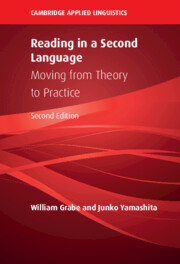Book contents
- Reading in a Second Language
- The Cambridge Applied Linguistics Series
- Reading in a Second Language
- Copyright page
- Dedication
- Contents
- Figures
- Tables
- Preface
- Part I Foundations of Reading
- Part II Patterns of Variation in Reading
- Part III Developing Reading Comprehension Abilities
- Part IV Expanding Reading Comprehension Skills
- 15 Reading to Learn and Reading–Writing Relationships
- 16 Reading in Digital Contexts
- 17 Reading Fluency, Reading Rate, and Comprehension
- 18 Extensive Reading
- Part V Applications of Reading Research: Instruction and Assessment
- References
- Author Index
- Subject Index
18 - Extensive Reading
from Part IV - Expanding Reading Comprehension Skills
Published online by Cambridge University Press: 01 September 2022
- Reading in a Second Language
- The Cambridge Applied Linguistics Series
- Reading in a Second Language
- Copyright page
- Dedication
- Contents
- Figures
- Tables
- Preface
- Part I Foundations of Reading
- Part II Patterns of Variation in Reading
- Part III Developing Reading Comprehension Abilities
- Part IV Expanding Reading Comprehension Skills
- 15 Reading to Learn and Reading–Writing Relationships
- 16 Reading in Digital Contexts
- 17 Reading Fluency, Reading Rate, and Comprehension
- 18 Extensive Reading
- Part V Applications of Reading Research: Instruction and Assessment
- References
- Author Index
- Subject Index
Summary
Chapter 18: Extensive Reading. Extensive reading (ER) is understood here as an extensive amount of reading. It is not specifically tied only to enjoyable reading or easy reading, although both of these sources of reading are important. The fundamental idea is that a large amount of understandable input (i.e., within students’ linguistic competence) via reading will develop students’ language and knowledge resources through incidental implicit learning. The benefits of extensive reading emerge over time and is fundamental for developing advanced reading abilities. A large amount of reading (extensive reading) leads to better vocabulary knowledge, better background knowledge, and better reading comprehension. Research in both L1 and L2 of contexts are reviewed, and the role of extensive reading (L2) or amount of reading (L1) is the key foundation for reading development and advanced reading comprehension. The chapter concludes with implications for instruction.
Keywords
- Type
- Chapter
- Information
- Reading in a Second LanguageMoving from Theory to Practice, pp. 419 - 430Publisher: Cambridge University PressPrint publication year: 2022

